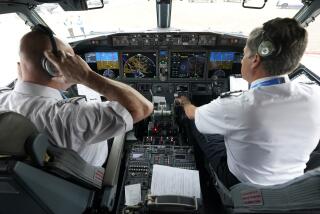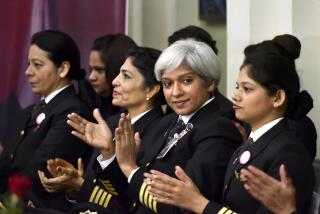But FAA Remains Skeptical of Researchers’ Recommendations : High-Altitude Naps Urged for Tired Pilots
- Share via
One often proposed solution to the dangers of pilot fatigue is legalization of a remedy that is obvious and widely practiced, but forbidden--naps in the cockpit.
Passengers may blanch at the idea of their captain snoozing while they watch a movie six miles above the Earth. But sleep researchers contend that this is a sensible way to cope with the flight crew exhaustion caused by late-night arrivals, early-morning departures and time-zone crossings.
Although air travel is generally safe, the experts say it could be safer still if human frailties were considered in the design of flight rules, pilot schedules and the planes themselves.
Some in the flying business, however, are reluctant to acknowledge fatigue as a concern. The Federal Aviation Administration has publicly voiced skepticism that sleepy pilots create a hazard in the skies. The airlines seem to fear that proposed rule changes would make scheduling more difficult, and some pilots fret that they would lose the large blocks of free time they now enjoy.
Industry observers, moreover, contend that one of the most powerful impediments to change is the very image of the airline pilot: fit, trim and male, calm, confident and capable. Surely such a person can deal with a little thing like sleepiness.
“There is a widely held belief that mental toughness, good management or physical fitness will overcome sleepiness. That is categorically incorrect,” said Dr. David Dinges, a sleep researcher at the University of Pennsylvania. “Your brain still needs sleep, and you get See related stories, Page 2.
yourself into serious trouble when you try to tough that out.”
Several approaches are being considered: cockpits that monitor their operators, medicines that help flight crews sleep when off duty, schedules that figure in the time of departure and the direction of travel as well as the length of the work day.
But one of the easiest and simplest solutions is the nap.
Looks at Safety Benefits
“It’s common knowledge that people are napping in the cockpit because they are so tired,” said R. Curtis Graeber, a sleep scientist at the NASA-Ames Research Center in California. “We are looking very closely at the potential safety benefits of allowing limited napping in the seat.”
The U.S. Air Force encourages its crews to nap on long cargo flights, and some foreign countries, Britain and West Germany among them, allow sleeping in airline cockpits. Under Federal Aviation Administration rules, however, napping is considered careless and reckless operation of the aircraft.
But on the long mid-flight stretches across continents and oceans, pilots have little to do but monitor their dials. Nature takes its course. In interviews with the Associated Press, pilots reported frightening instances of awakening to find their two colleagues sound asleep as the airliner cruised through the night skies.
Graeber proposes that naps be carefully scheduled so each member of the flight crew anticipates a rest period.
‘All Three Asleep’
“Napping will be very helpful, if it’s ever implemented,” agreed Mary Carskadon, a sleep researcher at Brown University. “It makes so much more sense to schedule it in than to all of a sudden have all three members of the flight crew asleep because no one is scheduled to sleep.”
Far more difficult, the experts agree, is improving pilot schedules. Rules set by the Federal Aviation Administration and union agreements dictate how many hours a day pilots can be on duty and in the air. But the standards allow myriad permutations of day and night departures and arrivals that often leave crews out of synchronism with their internal circadian clocks.
“I think pilot scheduling is as good as it can be right now reflecting what we know,” said T. Alan McArtor, head of the FAA. “As we understand it better, the scheduling, I think, will reflect that.”
McArtor and airline officials are awaiting results of research being conducted jointly by NASA, the Air Line Pilots Assn. and United Airlines.
Monitoring Brain Waves
Beginning this fall, Graeber and other researchers will fly with pilots on long, over-ocean routes, monitoring their body temperatures and brain waves as they fly through the night.
The resulting advice may not please either pilots or airlines.
Pilots, often vehement critics of schedules, might find their flight time spread over a longer calendar period, eliminating the intense two to three weeks of flying that gives them the rest of the month off.
Airlines, already pinched by deregulatory competition and a pilot shortage, may have trouble staffing their cockpits and paying additional salaries if researchers say pilots should fly reduced schedules.
FAA scheduling regulations have changed little since the 1930s, when lumbering prop planes rarely crossed more than one time zone a day. Among those who think they can be improved is John Lauber, a sleep researcher on the National Transportation Safety Board.
“An arbitrary restriction on flight and duty time and mandatory rest time that doesn’t take into account circadian factors is simply not 20th Century,” he said. “We know that an hour of sleep is not an hour of sleep, depending on when you take it. One of the biggest improvements we could make in our regulations would be to recognize those factors and adjust schedules appropriately.”
Want Refined Schedules
The experts contend that schedules should consider the time of departure, the number of time zones crossed and the direction of travel. (The body adjusts more quickly when traveling west to east than east to west.)
Another part of the problem is the plane itself. The modern cockpit is a fine place for involuntary slumber. The lights are dim. The seats are comfortable. The air rushes past with a soothing hum.
Planes are so automated that they quite literally fly themselves. Except while landing and taking off, there is often little for crew members to do. The newest planes don’t even require a flight engineer, so standard crew size is being reduced from three members to two. Some pilots and sleep experts complain that this increases the odds that the entire crew will doze off.
“The fewer people in the cockpit, the fewer safeguards you have,” said Dr. Martin Moore-Ede, a sleep expert at Harvard Medical School. “It’s easier for two people to nod off than three.”
Sees Better Odds
But Delmar Fadden, a Boeing administrator, asserts that just the opposite is likely: “If there are only two in the cockpit, both know that they can’t rely on a third person, so they are more attentive to the tasks they are doing and are much less likely to allow themselves to go to sleep.”
Fadden, who establishes design requirements for the Boeing 747 and 767, said: “We can’t do a lot about the fact that the crew might be fatigued. What we try to do is make the airplane tolerant of the crew’s reaction.”
This means designing planes to be safe even when flown by bored, drowsy, inattentive pilots. If something goes wrong, such as a generator failure, the plane automatically compensates without waiting for the crew to act.
Fadden said some planes being built will monitor their crews. Alarms will sound if pilots do nothing for 20 minutes. Such a lapse of activity could mean the pilots are daydreaming or worse.
Experimenting With Drug
Another possible solution, used by the British during the Falkland Islands crisis, is a drug to help pilots sleep before night flights. Bill Storm, a psychologist at Brooks Air Force Base in San Antonio, Tex., said the U.S. military is experimenting with the drug temazepam.
All of these suggested changes are intended to lessen the chance that cockpit fatigue will combine with bad weather, equipment failure and other random hazards to trigger a disaster.
“We run a very safe air transportation system,” said Lauber. “But we are pushing people harder. We know from anecdotal data that people are not as alert as they should be. They are falling asleep in some circumstances. I think it’s appropriate that we re-examine the way we approach these things.”
More to Read
Inside the business of entertainment
The Wide Shot brings you news, analysis and insights on everything from streaming wars to production — and what it all means for the future.
You may occasionally receive promotional content from the Los Angeles Times.










